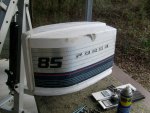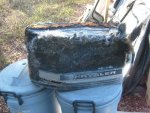DavidW2009
Petty Officer 1st Class
- Joined
- Sep 12, 2009
- Messages
- 272
I just purchased an older Chrysler outboard as a project to learn more about outboards.
The seller doesn't own a boat and never used the motor. He told me it belonged to a friend of the family's who passed away. He bought the motor from the estate.
He said the motor was 2-3 years old, circa late 70's, when a fire broke out in the marina storage and burned a bunch of boats, including the one that had this motor. The outside of the cover is scorched and the cover is no good.
He claims the cover had not been off since the fire. The latch handle is stuck.
I bought it because, except for the cover, the outside looked pretty good. The prop and lower end looked almost new. The motor has been on a pallet outside for a few years. The cover says it's a 75 HP MagnaPower Chrysler.
I brought it home and got the latch to unlatch. Removed the cover and found the insides somewhat sooty, but the wiring, etc. was not damaged.
The motor is a 3-cylinder with (3) carbs. The tag says it's a 90 Brake HP at 5,000 RPM. Model number appears to be: 907HA. The flywheel rotated when turned by hand, so it's not locked up.
I plan on taking this engine apart and seeing if it's any good. The carbs definitely need rebuilding. I built an engine stand for it. The motor came with power lift and trim.
Any experts here who could help me ID the engine? Year, etc.. It's interesting the cover says 75 HP and the tag says 90 HP. (I don't even know if Chrysler had a 90 HP 3-cylinder.)
Edit: Found this website that ID's the motor as a 1974 or 1975, 90 HP.
http://www.maxrules.com/ChryslerModels/90_150.html
The seller doesn't own a boat and never used the motor. He told me it belonged to a friend of the family's who passed away. He bought the motor from the estate.
He said the motor was 2-3 years old, circa late 70's, when a fire broke out in the marina storage and burned a bunch of boats, including the one that had this motor. The outside of the cover is scorched and the cover is no good.
He claims the cover had not been off since the fire. The latch handle is stuck.
I bought it because, except for the cover, the outside looked pretty good. The prop and lower end looked almost new. The motor has been on a pallet outside for a few years. The cover says it's a 75 HP MagnaPower Chrysler.
I brought it home and got the latch to unlatch. Removed the cover and found the insides somewhat sooty, but the wiring, etc. was not damaged.
The motor is a 3-cylinder with (3) carbs. The tag says it's a 90 Brake HP at 5,000 RPM. Model number appears to be: 907HA. The flywheel rotated when turned by hand, so it's not locked up.
I plan on taking this engine apart and seeing if it's any good. The carbs definitely need rebuilding. I built an engine stand for it. The motor came with power lift and trim.
Any experts here who could help me ID the engine? Year, etc.. It's interesting the cover says 75 HP and the tag says 90 HP. (I don't even know if Chrysler had a 90 HP 3-cylinder.)
Edit: Found this website that ID's the motor as a 1974 or 1975, 90 HP.
http://www.maxrules.com/ChryslerModels/90_150.html
Last edited:





















